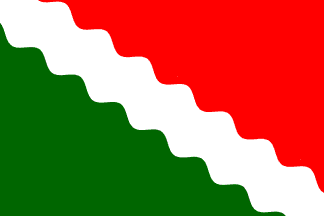
by Thanh-Tâm Le, 4 Febuary 1999

Last modified: 2004-07-31 by dov gutterman
Keywords: puerto rico | san sebastian |
Links: FOTW homepage |
search |
disclaimer and copyright |
write us |
mirrors

by Thanh-Tâm Le, 4 Febuary 1999
See also:
This city of 38,799 inhabitants was founded in 1752. The red
symbolizes our Patron Saint San Sebastián Mártir [Sebastia'n
Ma'rtir], and the heroic deeds of September 24, 1868, when our
town was the place where blood was shed during the events
originating in the Revolutionary Movement of Lares. The green
represents the mountains of the Pepino, and the white wavy stripe
stands for the Río Culebrinas.
Thanh-Tâm Le, 4 Febuary 1999
The original name was San Sebastián de las Vegas y el Pepino,
because of its location in an extensive valley protected by
mountains, watered by the Culebrinas and Guatemala rivers, and by
the locally wooded hills called "pepinos" (cucumbers),
characteristic of the karsic zone The three arrows represent
Patron Saint of the population, San Sebastián Mártir,
officially named in 1869. The arrows constitute the attribute of
this Saint. According to tradition he was killed with arrows by
his pursuers, giving this way testimony of faith. The arrows that
appear in the old seal of the population perpetuate the use of
its symbolism. The red color of the shield has in addition
another symbolism; the faith of the martyr. It recalls that San
Sebastián was the first town of Puerto Rico in the course of a
combat operation, blood for the national freedom of Puerto Rico
was spilled. It was in effect, in the plaza of the town, next to
the Parochial Church, on September 24, 1868, where by the gun
fire of loyal milicianos of the Spanish regime, Venancio Roman
fell along with other patriotics of Lares who came to occupy the
military quarters of Pepino. The Mountains: With silverplated
borders, represent the characteristic mountains (Pepinos) that
dominate the area from which it derives its name. The Crown: Is
the heraldic standard used to identify towns, villas and cities.
It symbolizes the defense and conservation of the municipal
traditions and the union of intentions that must reign between
the inhabitants of a municipality. The Sugar Cane and Coffee
Branches: They represent main agricultural products of the zone
where the population is based.
Nelson Román, 29 July 2004